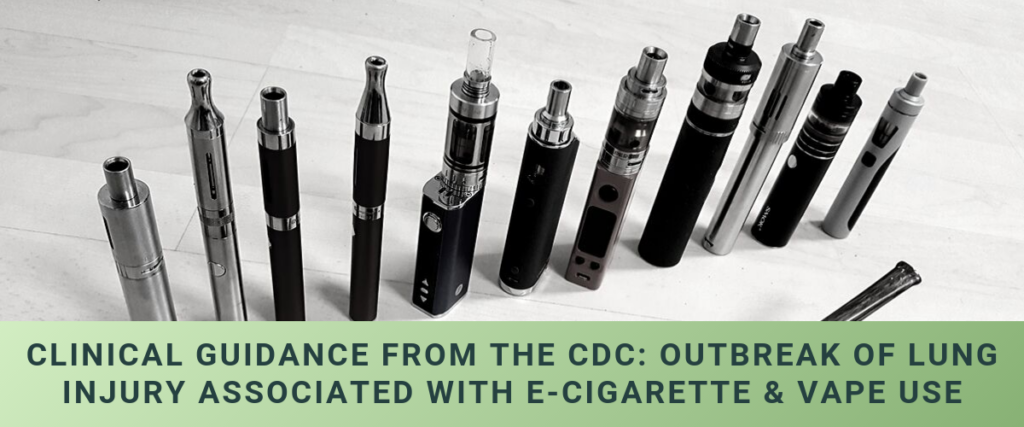
From the CDC: Outbreak of Lung Injury Associated with E-Cigarette/Vape Use, Including Maryland
The CDC, FDA, state and local health departments, and other clinical and public health partners are investigating a multistate outbreak of lung injury associated with use of e-cigarette, or vaping, products. There have been 23 reported cases of lung injury associated with using vaping products in Maryland, and Virginia reported its first death this week.
The following information, including recommendations for clinicians, was developed by the CDC for distribution. Local contact information for reporting has been identified and confirmed by MCMS staff. To access the CDC’s primary web page for healthcare providers, click here.
What We Know
- As of October 3, 2019, 1,080 lung injury cases associated with using vaping products have been reported to the CDC from 48 states and 1 U.S. territory.
- Eighteen deaths have been confirmed in 15 states: Alabama, California (2), Delaware, Florida, Georgia, Illinois, Indiana, Kansas (2), Minnesota, Mississippi, Missouri, Nebraska, New Jersey, Oregon (2), and Virginia.
- All patients have reported a history of using vaping products.
- Most patients report a history of using THC-containing products. The latest national and regional findings suggest products containing THC play a role in the outbreak.
- Approximately 70% of patients are male.
- Approximately 80% of patients are under 35 years old.
- 16% of patients are under 18 years old
- 21% of patients are 18 to 20 years old
Reporting Possible Cases
As this investigation continues, CDC encourages clinicians to report possible cases of vaping-associated lung injury to their local and state health department for further investigation. Please note: the Maryland Secretary of Health has issued a directive and order regarding reporting beginning October 3, 2019. All providers licensed by the state of Maryland must:
- Become familiar with the criteria for a suspected case of vaping associated lung injury, which is as follows: Use of any e-cigarette (“vaping”) or dabbing in 90 days prior to symptom onset AND Pulmonary infiltrate, including opacities on plain film chest radiograph or groundglass opacities on chest CT AND No alternative plausible diagnoses (e.g., infectious, cardiac, rheumatologic, or neoplastic process);
- Submit, within one working day, telephonic or written morbidity reports of suspected vaping associated lung injury to the local health department for the jurisdiction in which the health care is located;
- Consult the Maryland Department of Health Vaping Associated Lung Injury website for updated information and additional resources at phpa.health.maryland.gov/OEHFP/EH/Pages/VapingIllness.aspx;
- Educate and instruct the patient on appropriate measures to prevent further injury.
Local Health Departments, for reporting purposes:*
All reports in Maryland should be sent directly to the county health department, not to the Maryland Department of Health’s Environmental Health Bureau. Telephonic reporting is preferred in Maryland.
- Montgomery County Department of Health and Human Services: M-F Business Hours – 240.777.1755 After Hours & Weekends – 240.777.4000
- District of Columbia Department of Health: 202.727.3616 or report cases using this web portal.
- List of Contact Information for All Maryland Local Health Departments
*Each organization was contacted by MCMS staff to request the correct contact information for reporting. This listing will be updated on a rolling basis. Question? Call MCMS at 301.921.4300.
If vaping product use is suspected as a possible cause for a patient’s lung injury, a detailed history of the substances used, the sources of products, and the devices used should be obtained, as outlined in the Health Alert Network (HAN). Efforts should be made to collect clinical samples and to determine if any remaining product, devices, and liquids are available for testing.
Recommendations for Clinicians
- Report cases of lung injury of unclear etiology and a history of vaping product use within the past 90 days to your state or local health department. Reporting of lung injury cases may help the CDC and state health departments determine the cause of these lung injuries.
- Ask all patients who report vaping product use within the last 90 days about signs and symptoms of respiratory illness.
- If vaping product use is suspected as a possible etiology of a patient’s lung injury, obtain detailed history regarding:
- Substance(s) used: nicotine, cannabinoids (e.g., marijuana, THC, THC concentrates, CBD, CBD oil, synthetic cannabinoids [e.g., K2 or spice], hash oil), flavors, or other substances
- Substance source(s): commercially available liquids (i.e., bottles, cartridges, or pods), homemade liquids, and re-use of old cartridges or pods with homemade or commercially bought liquids
- Device(s) used: manufacturer; brand name; product name; model; serial number of the product, device, or e-liquid; if the device can be customized by the user; and any product modifications by the user (e.g., exposure of the atomizer or heating coil)
- Where the product(s) were purchased
- Method of substance use: aerosolization or dripping
- Other potential cases: sharing e-cigarette or vaping products (devices, liquids, refill pods, or cartridges) with others
- Determine if any remaining product, including devices and liquids, are available for testing. Testing can be coordinated with the local or state health departments.
- Consider all possible causes of illness in patients reporting respiratory and gastrointestinal symptoms. Evaluate and treat for other possible causes of illness (e.g., infectious, rheumatologic, neoplastic) as clinically indicated. Consider consultation with specialists (pulmonary, infectious disease, critical care, medical toxicology) as appropriate.
- Clinical improvement of patients with lung injury associated with e-cigarette use has been reported with the use of corticosteroids. The decision to use corticosteroids should be made on a case-by-case basis based on risks and benefits and the likelihood of other etiologies.
- Lipoid pneumonia associated with inhalation of lipids in aerosols generated by e-cigarettes or vaping products has been reported based on the detection of lipid-laden alveolar macrophages obtained by bronchoalveolar lavage (BAL) and lipid staining (e.g., Oil Red O, Sudan Black). The decision about whether to perform a BAL should be based on individual clinical circumstances.
- Lung biopsies have been performed on some patients. If a lung biopsy is obtained, lipid staining may be considered during pathologic examination, and is best performed on fresh tissue. Routine pathology tissue processing (including formalin-fixation and paraffin-embedding) can remove lipids. Conducting routine tissue processing and histopathologic evaluation is still important. Consider consultation with specialists in pulmonary medicine and pathology to help inform any evaluation plan.
- Patients who have received treatment for lung injury related to e-cigarette or vaping product use should undergo follow-up evaluation as clinically indicated to monitor pulmonary function.
- Consider asking the medical examiner or coroner’s office and hospital pathologists to report possible deaths, especially those without an alternative, likely diagnosis. If individuals are identified after death or at autopsy who showed signs of lung injury as described above, medical examiners and coroners are encouraged to report the cases to their local or state health department.
If a lung biopsy or autopsy is performed on a patient suspected of lung injury related to vaping product use, consider submission of fixed lung biopsy tissues or autopsy tissues to the CDC for evaluation. Testing can include evaluation for lipids on formalin-fixed (wet) lung tissues that have not undergone routine processing. Routine microscopic examination will be performed, as well as infectious disease testing, if indicated, on formalin-fixed (wet) tissues, or formalin-fixed, paraffin-embedded tissue specimens. For more information, see Specimen Submission Guidance for Pathologic Evaluation of Tissue Specimens from Cases of Pulmonary Disease Associated with E-Cigarette Product Use.
Other Considerations
Clinicians routinely consider multiple possible etiologies when evaluating and treating patients presenting with respiratory symptoms. In some cases, treatment directed at one or more of these etiologies must be initiated before the results of diagnostic testing, or other clinical features enable the list of possibilities to be narrowed.
- For the coming flu season, CDC recommends that clinicians strongly consider respiratory infections such as influenza, as well as lung injury associated with vaping in all patients presenting with respiratory symptoms and a history of vaping.
- Clinicians are further advised that it may not be possible to definitively distinguish between respiratory infection and lung injury associated with vaping using available testing. Therefore, therapy directed at both may be necessary. Decisions on the initiation or discontinuation of treatment should be based on specific clinical features and, when appropriate, in consultation with specialists.
Resources for Physicians & Medical Practices
Laboratory Clinical Sample Collection, Storage, and Submission Guidance for Lung Injury Associated with Vaping
The purpose of this document is to provide general sample collection, storage, and shipping guidance for healthcare providers and public health laboratory personnel involved in the care of patients who meet, or are highly suspected of meeting, the case definition for lung injury related to vaping. For information on the submission of non-tissue samples, please contact NCEHSampleLogistics@cdc.gov.
This guidance document will assist health departments, healthcare providers, medical examiners or coroners, and pathologists with submission of tissue specimens that could be collected from cases of lung injury associated with vaping product use.
E-Cigarette 101 Video (long form and short form)
The Association of State and Territorial Health Officials (ASTHO) and CDC’s Office on Smoking and Health (OSH) recently developed a video with CDC expert Dr. Brian King giving an ‘e-cigarette 101’ talk for clinicians and public health professionals.
Clinician Outreach and Communication Activity (COCA)
On September 19, 2019 CDC experts hosted a Clinician Outreach and Communication Activity (COCA) Call. CDC experts described e-cigarette and vaping terminology; summarized frequent Clinical, Laboratory, Radiographic, and Pathologic Findings and Outcomes among cases; and discussed recommendations for clinicians.
Outbreak of Lung Injury Associated with E-cigarette Product Use or Vaping: Information for Clinicians Presentation. Download presentation in PDF format.
This PowerPoint presentation is being provided for clinicians to use to review e-cigarette and vaping terminology, clinical features reported among cases of lung injury in recent outbreaks, and CDC recommendations for clinicians.
Poster (For Print)
This Poster for Clinical Settings is available for use in healthcare settings to encourage conversation between patients and providers about vaping.
Publications
- MMWR: Characteristics of a Multistate Outbreak of Lung Injury Associated with Vaping — United States, 2019
- MMWR: Vaping Among Persons with Associated Lung Injury — Illinois and Wisconsin, April–September 2019
- MMWR: Severe Pulmonary Disease Associated with Electronic-Cigarette–Product Use — Interim Guidance
- MMWR: Notes from the Field: Outbreak of Electronic-Cigarette Associated Acute Lipoid Pneumonia—North Carolina, July–August, 2019
- New England Journal of Medicine: Pulmonary Illness Related to E-Cigarette Use in Illinois and Wisconsin — Preliminary Report
- New England Journal of Medicine: Pulmonary Lipid-Laden Macrophages and Vaping
- New England Journal of Medicine: Imaging of Vaping-Associated Lung Disease
CDC Resources
- Get the facts about electronic cigarettes, their health effects and the risks of using e-cigarettes
- E-cigarettes and Youth: What Health Care Providers Need to Know
- E-cigarettes shaped like USB flash drives: Information for Parents, Educators, and Health Care Providers
- Marijuana and Public Health
Relevant Reports from the Surgeon General
Substance Abuse and Mental Health Services Administration
Quitting Resources
- SmokeFree.gov
- How to Quit Smoking: This CDC web page provides free resources, including the quitSTART app and how to build a quit plan.
- Smokefree Teen
- Truth Initiative
National Institute on Drug Abuse for Teens
FDA Resources
